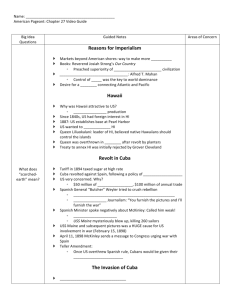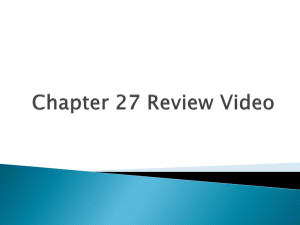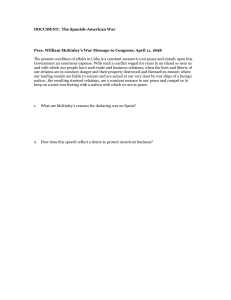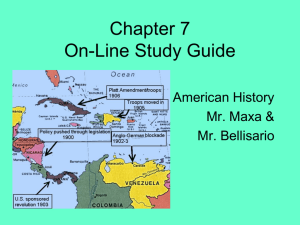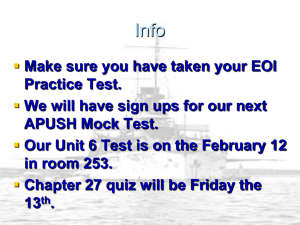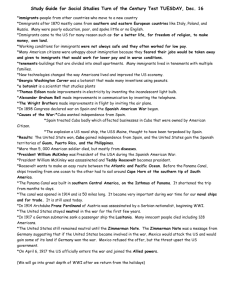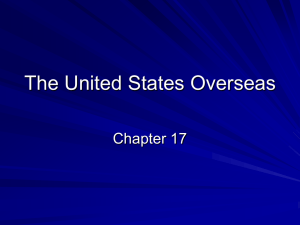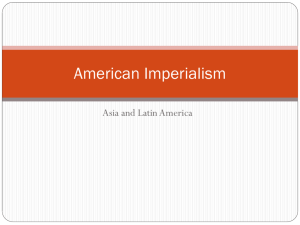AP U
advertisement
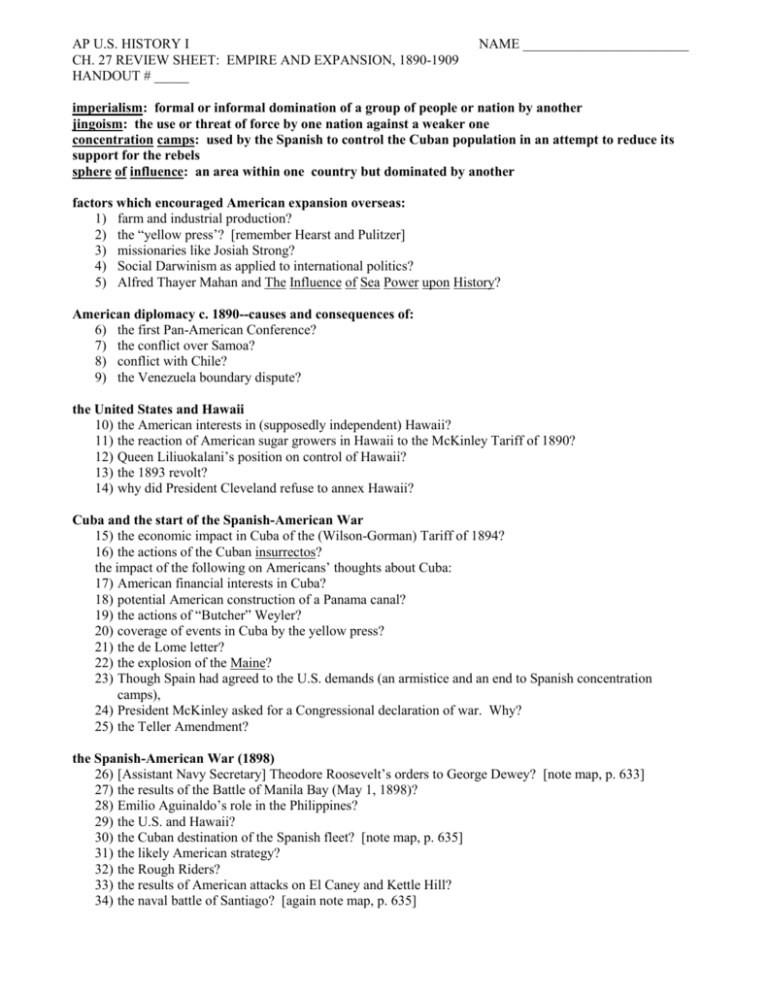
AP U.S. HISTORY I CH. 27 REVIEW SHEET: EMPIRE AND EXPANSION, 1890-1909 HANDOUT # _____ NAME ________________________ imperialism: formal or informal domination of a group of people or nation by another jingoism: the use or threat of force by one nation against a weaker one concentration camps: used by the Spanish to control the Cuban population in an attempt to reduce its support for the rebels sphere of influence: an area within one country but dominated by another factors which encouraged American expansion overseas: 1) farm and industrial production? 2) the “yellow press’? [remember Hearst and Pulitzer] 3) missionaries like Josiah Strong? 4) Social Darwinism as applied to international politics? 5) Alfred Thayer Mahan and The Influence of Sea Power upon History? American diplomacy c. 1890--causes and consequences of: 6) the first Pan-American Conference? 7) the conflict over Samoa? 8) conflict with Chile? 9) the Venezuela boundary dispute? the United States and Hawaii 10) the American interests in (supposedly independent) Hawaii? 11) the reaction of American sugar growers in Hawaii to the McKinley Tariff of 1890? 12) Queen Liliuokalani’s position on control of Hawaii? 13) the 1893 revolt? 14) why did President Cleveland refuse to annex Hawaii? Cuba and the start of the Spanish-American War 15) the economic impact in Cuba of the (Wilson-Gorman) Tariff of 1894? 16) the actions of the Cuban insurrectos? the impact of the following on Americans’ thoughts about Cuba: 17) American financial interests in Cuba? 18) potential American construction of a Panama canal? 19) the actions of “Butcher” Weyler? 20) coverage of events in Cuba by the yellow press? 21) the de Lome letter? 22) the explosion of the Maine? 23) Though Spain had agreed to the U.S. demands (an armistice and an end to Spanish concentration camps), 24) President McKinley asked for a Congressional declaration of war. Why? 25) the Teller Amendment? the Spanish-American War (1898) 26) [Assistant Navy Secretary] Theodore Roosevelt’s orders to George Dewey? [note map, p. 633] 27) the results of the Battle of Manila Bay (May 1, 1898)? 28) Emilio Aguinaldo’s role in the Philippines? 29) the U.S. and Hawaii? 30) the Cuban destination of the Spanish fleet? [note map, p. 635] 31) the likely American strategy? 32) the Rough Riders? 33) the results of American attacks on El Caney and Kettle Hill? 34) the naval battle of Santiago? [again note map, p. 635] the United States acquires an empire 35) the status of Cuba? of Guam and Puerto Rico? [note map, p. 630] 36) the American decision about the Philippines? why did the United States pay $20 million to Spain? 37) the arguments of the Anti-Imperialist League against acquiring the Philippines? the arguments of expansionists? [note the reference to a famous poem by Kipling, p . 640] 38) the Foraker Act? 39) the Insular Cases? 40) benefits to Cubans from the American conquest? 41) per the Teller Amendment, the U.S. withdrew from Cuba in 1902--but the terms of the Platt Amendment? 42) the impact on world powers of “the splendid little war”? the war’s impact within the United States? 43) the cause of U.S.-Filipino conflict? what was the conflict with Americans’ “little brown brothers” like? 44) benefits to Filipinos of American rule? when did the Philippines become free? China and the Open Door Policy 45) the European powers and China c. 1895? 46) American interest in China? 47) John Hay’s Open Door policies? [two ideas; pp. 642-643, p. 646] 48) the Boxer Rebellion? 49) the end of the Boxer Rebellion? the election of 1900: McKinley vs. Bryan again 50) McKinley’s presidential record (especially the “full dinner pail”)? 51) why was TR chosen as McKinley’s vice presidential candidate? 52) Bryan’s principal position? 53) election results? a “mandate” for imperialism? TR becomes president 54) the death of McKinley? 55) TR’s background? 56) his main idea about the presidency? TR and the Panama Canal [note the famous photograph of TR in Panama, p. 648] 57) the battleship Oregon and the U.S. need for a canal? 58) the Hay-Pauncefote Treaty with Great Britain? 59) the terms of the proposed U.S.-Colombia canal treaty? 60) Colombia’s reaction to the proposed treaty? 61) U.S. involvement in the Panamanian revolt against Colombia? 62) the terms of the Hay-Bunau-Varilla Treaty with Panama? 63) the work of William Gorgas at Panama? of George Goethals? TR and the big stick [note cartoon, p. 649] 64) the Roosevelt Corollary to the Monroe Doctrine? 65) U.S. actions in the Dominican Republic (1905)? 66) U.S. actions in Cuba (1906)? 67) [not a result of the big stick] T.R.’s Nobel Prize? Japan and the Gentleman’s Agreement 68) opposition in California to the Japanese? San Francisco’s action? 69) the Gentleman’s Agreement (1907)? 70) the voyage of the Great White Fleet? 71) the Root-Takahira Agreement (1908)?

